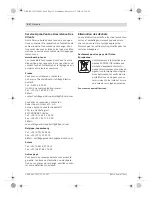
English |
19
Bosch Power Tools
2 609 004 767 | (17.11.10)
Replacing the Sanding Sheet
(see figures A–B)
To remove the sanding sheet
6
, lift it from the
side and pull it off of the sanding plate
4
.
When attaching a new sanding sheet, remove
any dust or debris from the sanding plate
4
, e.g.,
with a brush.
The surface of the sanding plate
4
is fitted with
Velcro backing for quick and easy fastening of
sanding sheets with Velcro adhesion.
Press the sanding sheet
6
firmly against the bot-
tom side of the sanding plate
4
.
To ensure optimum dust extraction, pay atten-
tion that the punched holes in the sanding sheet
match with the holes in the sanding plate.
The alignment aid
7
can be used for alignment of
the sanding sheet
6
on the sanding plate
4
.
Place the sanding sheet with the Velcro facing
upward on the alignment aid. Press the cams of
the alignment aid into two holes of the sanding
plate and roll off the sanding sheet from the
alignment aid. Press the sanding sheet firmly
against the sanding plate.
Selection of the Sanding Plate
Depending on the application, the machine can
be equipped with sanding plates of different
hardness:
– Sanding plate, medium (black): Suitable for
all sanding work; universally usable.
– Sanding plate, soft (grey, accessory): Suita-
ble for intermediate and fine sanding, incl. on
convex surfaces.
Replacing the Sanding Plate
(see figures C–D)
Note:
Replace a damaged sanding plate
4
imme-
diately.
Pull off the sanding sheet or the polishing acces-
sory. Unscrew the four screws
8
completely and
remove the sanding plate
4
.
Clean the upper side of the new sanding plate
4
.
Apply a thin coat of synthetic grease to the outer
ring hatched grey in the figure.
Attach the new sanding plate
4
and tighten the
four screws again.
Note:
A damaged sanding-plate base
9
may be
changed only by an authorised after-sales serv-
ice agent for Bosch power tools.
Dust/Chip Extraction
f
Dusts from materials such as lead-containing
coatings, some wood types, minerals and
metal can be harmful to one’s health. Touch-
ing or breathing-in the dusts can cause aller-
gic reactions and/or lead to respiratory infec-
tions of the user or bystanders.
Certain dusts, such as oak or beech dust, are
considered as carcinogenic, especially in
connection with wood-treatment additives
(chromate, wood preservative). Materials
containing asbestos may only be worked by
specialists.
– As far as possible, use a dust extraction
system suitable for the material.
– Provide for good ventilation of the work-
ing place.
– It is recommended to wear a P2 filter-
class respirator.
Observe the relevant regulations in your
country for the materials to be worked.
f
Prevent dust accumulation at the work-
place.
Dusts can easily ignite.
Integrated Dust Extraction with Dust Box
(see figures E–H)
Attach the dust box
3
onto the extraction outlet
10
until it latches.
The filling level of the dust box
3
can easily be
checked through the transparent container.
To empty the dust box
3
, pull it off toward the
bottom with a twisting motion.
Before opening the dust box
3
, it is recommend-
ed to loosen the dust from the filter element by
gently striking it against a firm support (as
shown in the figure).
Hold the dust box
3
firmly, fold the filter element
11
upward and empty the dust box. Clean the thin
plates of the filter element
11
with a soft brush.
Note:
To ensure optimum dust extraction, emp-
ty the dust box
3
in good time and clean the fil-
ter element
11
at regular intervals.
When working vertical surfaces, hold the power
tool in such a manner that the dust box
3
faces
downward.
OBJ_BUCH-1334-001.book Page 19 Wednesday, November 17, 2010 10:18 AM
















































